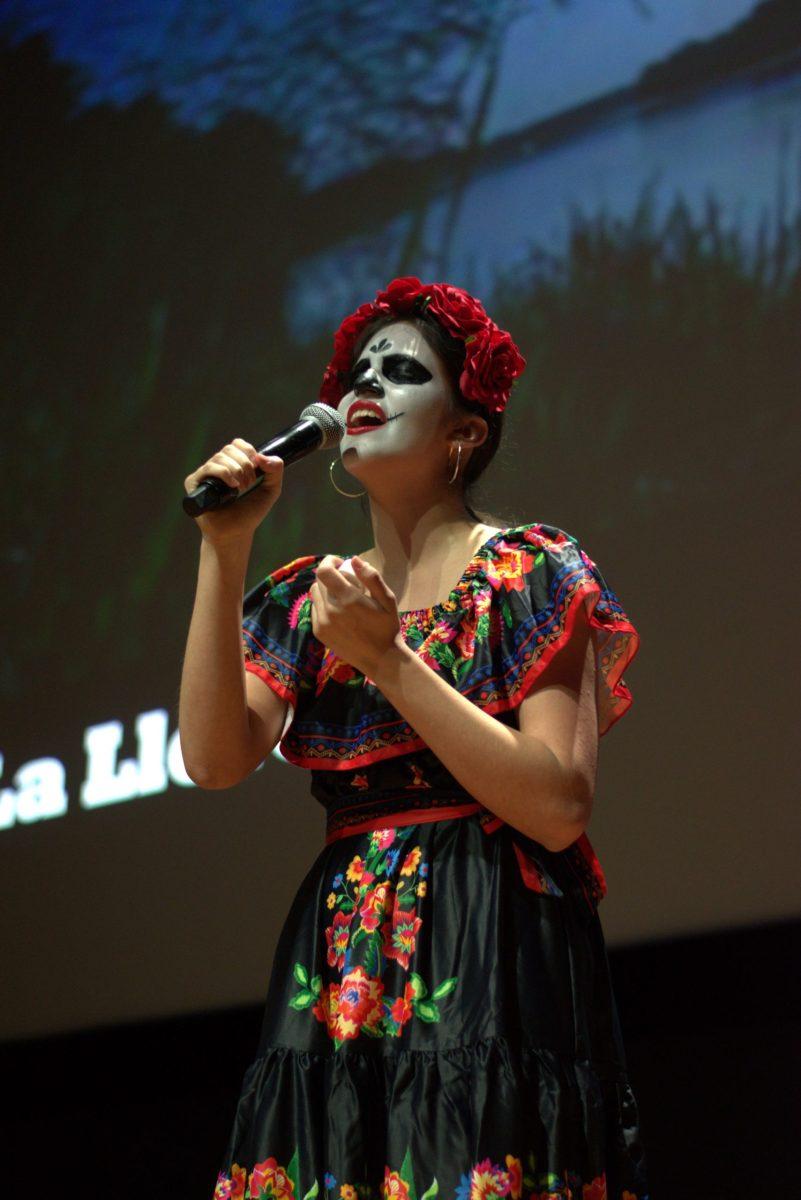Piercing cries of pain overcome the steady murmur of a river as La Llorona wanders hopelessly in search of the children she drowned; this infamous figure from Latin American culture was brought to life on stage on Feb. 23, as one student channeled her tale of despair to explore grief and loss through a unique cultural lens.
La Llorona is the eponymous figure of La Llorona, a Mexican folk song from Oaxaca popularized in the mid-20th century, and the song has persisted well into the 21st century. The origin of the myth of La Llorona is unknown, but this figure has spread throughout Latin American tradition as a tale of horror, caution, love and remorse, often depicting a young woman clad in a white dress constantly weeping because of the death of her children, which she drowned in a river. During the iWeek Global Talent Show, mathematics freshman Lydia Esparza won second place for her rendition of Carmen Goett’s version of La Llorona’s hauntingly beautiful song while dressed like a true catrina: with all the skeletal and floral accouterments associated with the Day of the Dead.
“I wanted to pay homage to the Day of the Dead with my skeleton makeup and Mexican dress becauseLa Llorona and the Day of the Dead are closely tied and prominent in Hispanic culture,” Esparza said.
Like many Latin Americans, Esparza grew up in a cultural crossroads as she grew up in Texas with a Mexican father and Puerto Rican-Cuban mother. Despite speaking Spanish at home and immersing herself in majority Hispanic communities, high school brought a time of cultural conflict. Esparza now found herself in a majority white world at a time where the things other people said about her and her culture had a large impact.
“Growing up I heard from other people that Hispanics always had to be this or that, but my parents always told me and my sisters that you can do what you set your mind to,” Esparza said. “You don’t have to worry about what other people say about you. You just have to worry about you. I see the fact that I made it [to UTD] as a success, and I no longer let what other people do or say against me hold me back.”
To Esparza, her performance was a way to interact with the rich cultural background of her Mexican father and Puerto Rican-Cuban mother who had introduced her to all sorts of food, art and music. The Global Talent Show was her opportunity to share what she loved about her culture with others while bonding over shared artistic appreciation.
“We know that there are so many cultures here at UTD, but to see it represented in a talent show is something else,” Esparza said. “So much is conveyed through the different dances popular in different countries, and it was really awesome to see cool representations of the nuance between cultures through these performances.”
During her performance, Esparza channeled the morose and tragic themes of La Llorona’s tale which she chose to interpret for this performance. In her mind she wandered through a candle lit graveyard in a hopeless search for her children whom she had killed, carrying the unforgivable burden of guilt. Singing the last notes of her song, Esparza collapsed on the floor due to the overwhelming grief of the spirit’s loss.
“In my performance I imagined her walking around this graveyard battling with the remorse of her actions and yearning to be able to undo these sins I have committed,” Esparza said. “She can’t have that happiness and joy she yearns for because that part of her life is gone.”
Assistant professor of philosophy Humberto González Núñez said that while often overlooked by Western media, the stories and myths of Latin America have been used to paint critical and beautiful vignettes of the past, and the tale of La Llorona is a prime example of this through its constant retelling and recontextualization across various artistic mediums. For instance, the 2019 horror film, La Llorona by Guatemalan director Jayro Bustamante uses the story of La Llorona to explore a 20th century atrocity.
“Jayro Bustamante’s La Llorona is actually a reflection of genocide in Central America while at the same time using the tropes of horror films to allow us to rethink how we understand the past and these genocides,” Núñez said. “It uses this artistic medium to help audiences think through the effects of U.S. foreign policy in Central America and the different intercultural relationships between the different ethnicities of Central America and how that influenced how those genocides unfurled.”
With no definitive origin, the myth of La Llorona has been adapted to express loss as seen with Esparza’s performance, as a cautionary tale to keep children behaved and as a mirror reflecting the wrongs of the past onto the present, demanding both confrontation and introspection.
Amid the anti-immigrant and anti-Hispanic rhetoric pushed by figures like Texas Gov. Greg Abbott and President Joe Biden, Núñez said that music and art can humanize and bring understanding. While the tale of La Llorona might be novel to many, her sorrow and the beauty of her associated art is universal.
“We don’t want to ascribe to art this exaggerated force, but one of the things it can do is break with and critique certain stereotypes about Latin American identity,” Núñez said. “Latin America has excellent art, and beyond just the big name figures I hope this leads others to look into the often-overlooked aspects and figures of other cultures.”







